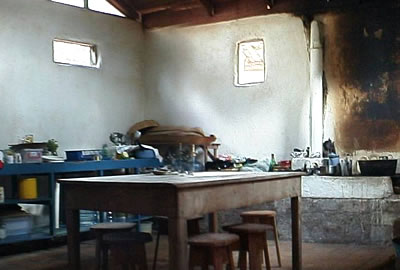December
17, 2000
Butterflies, Haciendas, and Las Seputuras
Today,
was a busy, fun day. We decided that we'd better put that
expensive 4 wheel drive to good use. We began with a trip
to the butterfly farm. This place is an offshoot of another
farm in la Cieba. Both were started by a Peace Corps volunteer,
Robert Gaillardo, in conjunction with the San Diego Zoo
who helped with funding and purchase the pupae. There, we
chatted with Robert, who started the place, and is now married
to a Honduran woman. He's also from Southern California,
but has no plans to return. He explained the whole process
and the entire life cycle of owl butterfly. The "farm"
is actually a net covered enclosure,
L-shaped, and filled with tropical plants, a waterfall and
dozens of different fluttering butterflies. Unfortunately,
many of the pupae hadn't hatched recently, so there weren't
as many butterflies as usual. Still, we did see a rather
large "owl" butterfly and some other interesting
red and black butterflies.
From
the Butterfly Farm, we crossed the river and drove up an
unpaved road and a very steep hill until we reached Hacienda
San Lucas. There we were greeted by Hacienda owner, Doña
Flavia, a Honduran woman whose family has owned the hacienda
and the surrounding 200 acres for the last 100 years. She
used to live in Kentucky and has three children who live
in the US. A couple of years back she returned to Honduras
to find the place so dilapidated that she had to almost
tear it all down and start over. With a lot of hard work
and effort, she has a lovely place that includes 2 rooms
for rent for $45 night inc. breakfast. The rooms have no
electricity, but do have some light run by 12 volt solar
powered batteries. Doña Flavia wants to revive homestyle,
traditional, Honduran cooking. She is doing this with the
aid of two or three local women who help cook over the open
fire in the kitchen. We stayed and had a wonderful lunch,
served on the front porch of the Hacienda, consisting of
all manner of savory items, including an incredible tamale,
stewed chicken, and pork ribs. She also offers ice cold
lemonade.
After the filling lunch, we took a walk around her property,
which includes marked trails, and a Mayan archeological
site called Las Sosas. Las Sosas is basically a bunch of
moss covered boulders, one of which, if you squint enough,
is a frog shaped rock. Myth has it that this is where Mayan
women came to give birth. From here, as with most of the
Hacienda San Lucas property, there are great views of the
entire valley. Eco-Hacienda San Lucas Copan, Honduras. Please
see the photo page "Moments"
for pictures of the butterfly farm and of Las Sosas.
Back at the Hacienda, we met two Americans who teach in
the bilingual school in Copan. They had walked up from the
town, planning an outing for later in the week with their
students. We gave them a ride back down and then drove to
Las Sepulturas, another set of ruins. Las Sepulturas means
the tombs. Originally, people thought that these were just
tombs, thus the name, but now it's thought that this was
a suburb of the main center of Copan, filled with homes
that include tombs underneath. We arrived at the entrance
and showed the guard/guide or tickets from the main Copan
Ruins from the day before (the ticket is good for both entrances).
The man insisted on showing us the way and wound up giving
us a tour of the ruins en espanol. Ultimately, it was worth
it, as he gave us quite a bit of information. At the end,
we tipped him 50L.
Part
6:
Where flying is a pleasure?
